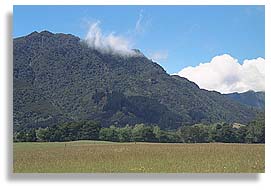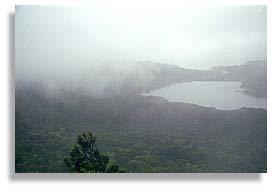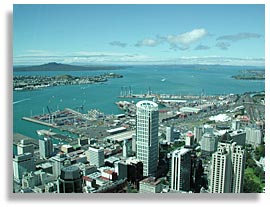|
"Undisturbed and exclusive possession
of the land, estates and forests" The Strength In It Interview with Sydney Jackson
Sydney Jackson is a longtime Maori community leader living in Auckland, New Zealand. This interview is part of an extended series of articles and interviews gathered by In Motion Magazine in the context of the 2000-2001 hearings of New Zealand's Royal Commission on Genetic Modification. In Motion Magazine travelled around New Zealand with Missouri Rural Crisis Center and National Family Farm Coalition president Bill Christison visiting farmers and community leaders and listening to their views about genetically modified organisms. Currently there are no commercial GE crops in New Zealand. After hearing the recommendations of the commission the New Zealand government will make a decision on whether or not GE crops will be allowed in New Zealand. This interview was conducted March 5, 2001 by phone (from San Diego, U.S.) by Nic Paget-Clarke. In Motion Magazine: What do you think of genetic engineering? Sydney Jackson: The Maori perspective on that is that we are opposed to the concept. It is totally in opposition to the philosophy by which we live and to our traditional beliefs. In Motion Magazine: Is it possible to relate the growth of the Maori movement to such processes as the Wai 262 claim? Sydney Jackson: Yes it is. In the Wai 262 claim, we say that we have always had ownership of this land and all its resources. This was confirmed in the Treaty of Waitangi (signed in 1840), which in the English translation said that we would have “full undisturbed and exclusive possession of the land, estates and forests”. The major cause for dispute between our two peoples since the Treaty was signed has been over what that meant. We have been clear -- it means what it says. The Wai 262 claim, or the flora and fauna claim, is a reaffirmation by us of the right of tino rantatiratanga. We have the right to protect the flora and fauna within each of our tribal boundaries. The best way of summarizing it, that I can think of, was first said by one of the original claimants, a man by the name of John Hippolite. He has since died, as unfortunately have many of the others. He said, that the claim cannot be just a matter of having the crown recognize our chieftainship over the forests but rather it must acknowledge why we seek it. This has to do with our understanding, even back then, that there were new things on the horizon like genetic engineering that might challenge both our understanding and our authority over what is important. That statement was made more than a decade ago when the claim was lodged.
Sydney Jackson: In the late 1960’s, Maoris began to openly articulate the things that we had been saying privately in our own meetings, and in submissions to the government, to bureaucrats. What changed here in the 1960’s, as things changed I suppose in many places throughout the world, was that young people in particular began to focus attention on the Treaty of Waitangi. On the fact that it hadn’t been honored. On discontents that had existed for over a hundred years. On injustices that had existed for a hundred and twenty years. We said, “Now, as a society, we have to correct these things.” That movement centered on such things as the right to protect our land, the right to settle land grievances, to have land that was stolen returned to us. The right to protect our heritage, to protect our language and our culture. It all began to come out into the open for the first time with the strength of the overwhelming majority of our people. It has found expression in a whole lot of ways, including submissions to the Waitangi Tribunal, which was set up in 1974. The Wai 262 claim is simply another avenue by which our people have sought to redress grievances and address complaints that we have. To seek ownership and protection of those things which are important to us. In Motion Magazine: It seems to me that in the fight against genetic engineering the Maori took a leadership role with the Wai 262 claim. Would you look at it that way? Sydney Jackson: Yes, that’s right. Effectively what we are saying is that the Royal Commission should really not have been appointed, or certainly should not make any decisions until such time as the Waitangi tribunal has heard this claim and decided on it. That’s one of the arguments that Maori have been putting forward because we haven’t yet had the opportunity before the tribunal to outline our particular concerns about genetic engineering. For example, the Iwi (tribe) that I come from has not yet completed our specific and particular presentation to the Tribunal and we are concerned, as one of the claimants, that our case might be jeopardized by articulating our position before the Commission rather than the Tribunal. In our view it would be tragic and it would be unjust if the general processes of the Commission were prejudicial to the Tribunal claim. It would also give rise to the often expressed view by Maori that the Crown wasn’t concerned about genetic modification when we first raised the issue over a decade ago but only moved to establish the Commission, quite rightly, after widespread agitation from the majority, I think, of the pakeha community. That only makes weaker the little faith that we have that our concerns might be noticed and our interests protected. In Motion Magazine: Wai 262 relates to the patenting of the flora and the fauna? Sydney Jackson: Yes, that’s right. To put it in simple terms, what it means is that they patent our plants which we use for what we call rongoa, our traditional medicines. Then, when we are not able to use them in the way that we traditionally have, we have to buy them back at exorbitant prices. That was, again, one of the fears that emerged at the time the claim was made, one of the dangers that was inherent in the patenting that was going on throughout the world. In Motion Magazine: What is the timeline for Wai 262? Sydney Jackson: We don’t know. It’s already been ten years. The dilemma for us is that the Tribunal isn’t given adequate finance to hear cases as quickly as they should so there’s a huge backlog of cases. The other thing is people are running around and running away because they are really frightened. I’m talking about the government and bureaucrats, in particular. They are running around because they don’t know what to do. In Motion Magazine: Because it would change the essence of the constitution? Sydney Jackson: We don’t have a written constitution as such. In Motion Magazine: It would change the interpretation of the Treaty? Sydney Jackson: Yes, We see that as the founding document and therefore it’s the basis on which we argue these cases. In Motion Magazine: If the Treaty is legally defined differently than what has been assumed would change? Sydney Jackson: Yes. Effectively what we have asked of the Tribunal is that they recommend positive steps to Maori and to the government, or the Crown, about how we can go about that matter. In submissions that Maori groups have been making, that’s what we’ve been saying.We think that there should be a total moratorium on further expansion of genetic modification research and trials and that this moratorium should stay in place until such time as the Tribunal has heard the case. Furthermore, all those projects which are now in place or which have been approved by ERMA should be subject to further review that gives more respect to the Treaty, which recognizes the Maori intellectual framework. That while the moratorium is in place Maori should be involved in a foremost ethical debate about the abstract assumptions behind genetic engineering as well as on the practical implementation of genetic modification research. What we’ve also asked is that Iwi, tribes, be funded so that we can develop our own research programs into these matters.
Sydney Jackson: That’s part of the claim but it’s also something that we are stating now in regards the Royal Commission. We want the moratorium and we want to have some funding because what the scientists say is that there is only one intellectual standard, that there is only one intellectual tradition that can be followed in these matters. That is what they describe, in their ignorance, as the western tradition. We say, well, it’s an ill-founded presumption in the first place, and we don’t agree. We want the money to do our own research so that we can show that we come from a different intellectual approach which is equally as valid. And so do other people and particularly other indigenous peoples. That tradition needs to be recognized as having equal validity, at least, to the western scientific intellectual tradition. That’s what we are seeking today. In Motion Magazine: How do you feel about the procedure of the Commission? Sydney Jackson: Maori groups have been participating, particularly in the last week. There are a lot of groups coming forward with submissions. Tremendous degree of unanimity In Motion Magazine: Is there community grassroots organizing in support of the Wai 262 claim? Sydney Jackson: Yes there is. At least one tribe, or a section of a tribe, is needed to make a claim to the Tribunal. In this particular claim, six tribes came together including, as I said, ours and made a decision that they would make a joint approach to the tribunal. What has happened since then is that many more tribes support that stand. In addition, there are Maori non-tribal, or pan-tribal organizations such as the New Zealand Maori Council which is set up by statute, and the New Zealand Maori Congress which is a federation of all the tribes throughout the land. They have come together on the question of genetic engineering and they have been appearing before the Royal Commission. They have been making submissions almost identical to what the claimants said ten years ago. There’s been a tremendous degree of unanimity developed in the period that this claim has sat in the Tribunal. In Motion Magazine: Can you tell me about the role immersion schools have played in recent developments in the Maori movement? Sydney Jackson: One of the weapons of colonialism is that they set out to destroy the language and the culture of the indigenous peoples. In 1867, because our people were far more literate in the English language than the majority of the settlers were, it was decided that the basis of education which the missionaries had set up, which was to teach in Maori, would be abolished. The settler government made the teaching of people in Maori illegal and introduced corporal punishment against our kids who dared to speak Maori in school. That survived until the 1960’s and the result was twofold. The literacy rate amongst our pupils began to fall. And, secondly, the language became imperiled.In the 1960’s, the realization that this was occurring lead to demands by our people, firstly, that Maori language be introduced into schools. That was done in all kinds of ways including one of the biggest petitions that we’ve ever had in this country. It lead to the formation by our people of what they called kohanga reo, and that was to take our children as babes and put them into what we called the cradles of the language, kuhungareo. To begin to teach them in our language. That was probably the most successful Maori initiative that we have developed in the last forty years. From that we developed Maori language schools for children up to 12. Slowly, we also brought about the formation of total immersion secondary schools and people can now go from the time that they are babies through almost to obtaining a university degree, doing it in Maori. Never bothering about doing it in English. That’s the objective that we would ideally like. To see our people being able to learn in Maori the whole way up. If they want to be a doctor, to do much of their study in Maori. That’s the vision. There are some degrees that you can obtain now in Maori. In Motion Magazine: What percentage of Maori speak Maori now? Sydney Jackson: It’still very low. About 12%. We are starved of finance by the government and we can’t get the number of schools that we desperately need to meet the demands and hopes of parents for their children. In Motion Magazine: When did the country become officially bilingual? Sydney Jackson: In the early ’80s. During one of the Labor governments. In Motion Magazine:That was a product of this same movement? Sydney Jackson: Yes it was. We demanded equality of the language in parliament, in the courts, and every aspect of life. Theoretically, we have it. In Motion Magazine: What role did Maori play in the nuclear free movement? Sydney Jackson: In the last 30 years, there have been four or five major protest movements, for want of a better term. One was the nuclear free movement which lead to the formation of the Nuclear Free and Independent Pacific Movement. There was the anti-apartheid movement which was really strong here. The Vietnam war. And others. In each of these, Maori have played a prominent role. In many instances, we’ve actually been the drive, kaha, the strength in it, because our people know what it is to be disadvantaged. You get into those things. You are able to take a more proactive approach than others might be prepared to take, to help drive a movement forward because in our own issues, in our own development, that’s what we’ve had to do. In Motion Magazine: And you would place the GE movement in that group? Sydney Jackson: Yes. In Motion Magazine: They are all directly related? Sydney Jackson: Yes they are. To come back to your initial question, for the Maori, the nuclear issue could never be divorced from the independence movement in the Pacific. The two went together. For instance, Tahitians would say, “Well, if we had control of our own country, and not the French, there would never have been nuclear testing in Tahiti”. And the Hawaiians would say a similar thing. People all around the Pacific have said that you can’t divorce the two issues. They go hand in hand. In Motion Magazine: And so with the GE movement, how would you relate the two? Sydney Jackson: In exactly the same way.
|
|||||||||||||||||||||||||||||||||||||||||||||
| Published in In Motion Magazine April 22, 2001. |
|||||||||||||||||||||||||||||||||||||||||||||
If you have any thoughts on this or would like to contribute to an ongoing discussion in the  What is New? || Affirmative Action || Art Changes || Autonomy: Chiapas - California || Community Images || Education Rights || E-mail, Opinions and Discussion || En español || Essays from Ireland || Global Eyes || Healthcare || Human Rights/Civil Rights || Piri Thomas || Photo of the Week || QA: Interviews || Region || Rural America || Search || Donate || To be notified of new articles || Survey || In Motion Magazine's Store || In Motion Magazine Staff || In Unity Book of Photos || Links Around The World || OneWorld / US || NPC Productions Copyright © 1995-2011 NPC Productions as a compilation. All Rights Reserved. |
|||||||||||||||||||||||||||||||||||||||||||||




